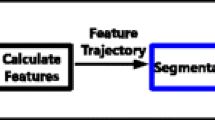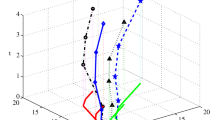Abstract
As an important issue in the trajectory mining task, the trajectory clustering technique has attracted lots of the attention in the field of data mining. Trajectory clustering technique identifies the similar trajectories (or trajectory segments) and classifies them into the several clusters which can reveal the potential movement behaviors of nodes. At present, most of the existing trajectory clustering methods focus on some spatial properties of trajectories (such as geographic locations, movement directions), while the spatial-temporal properties (especially the combination of spatial distances and semantic distances) are ignored, and thus some vital information regarding the movement behaviors of nodes is probably lost in the trajectory clustering results. In this paper, we propose a Joint Spatial-Temporal Trajectory Clustering Method (JSTTCM), where some spatial-temporal properties of the trajectories are exploited to cluster the trajectory segments. Finally, the number of clusters and the silhouette coefficient are observed through simulations, and the results show that JSTTCM can cluster the trajectory segments appropriately.













Similar content being viewed by others
References
Alon, J., Sclaroff, S., Kollios, G., & Pavlovic, V. (2003). Discovering Clusters in Motion Time-series Data. IEEE Computer Society Conference on Computer Vision and Pattern Recognition (pp. 375–381).
Andrienko, N., Andrienko, G., & Rinzivillo, S. (2016). Leveraging spatial abstraction in traffic analysis and forecasting with visual analytics. Information System, 57, 172–194.
Bao, J., Zheng, Y., Wilkie, D., & Mokbel, M. (2015). Recommendations in Location-based Social Networks A Survey. GeoInformatica, 19(3), 525–565.
Besse, P.C., Guillouet, B., Loubes, J.M., & Royer, F. (2018). Destination prediction by trajectory Distribution-Based model. IEEE Transactions on Intelligent Transportation Systems, 19(8), 2470–2481.
Campello, R.J.G.B., Moulavi, D., & Sander, J. (2013). Density-based Clustering based on Hierarchical Density Estimates. Lecture Notes in Computer Science, 7819, 160–172.
Chen, L., & Ng, R. (2004). On the Marriage of Lp-norms and Edit Distance. Thirtieth International Conference on Very Large Data Bases, 30, 792–803.
Chen, L., Ozsu, M., & Oria, V. (2005). Robust and Fast Similarity Search for Moving Object Trajectories. ACM SIGMOD International Conference on Management of Data, 491C–502.
Chen, J., Wang, R., Liu, L., & Song, J. (2011). Clustering of Trajectories based on Hausdorff Distance. 2011 International Conference on Electronics, Communications and Control (ICECC) (pp. 1940–1944).
Ester, M., Kriegel, H.P., Sander, J., & Xu, X. (1996). Density-based Algorithm for Discovering Clusters in Large Spatial Databases with Noise. 2nd International Conference on Knowledge Discovery and Data Mining (pp. 226–231).
Gaffney, S., & Smyth, P. (1999). Trajectory clustering with mixtures of regression models. Fifth ACM SIGKDD International Conference on Knowledge Discovery and Data Mining (pp. 63–72).
Lee, J.G., Han, J., & Whang, K.Y. (2007). Trajectory Clustering: A Partition-and-Group Framework. ACM SIGMOD Conference on Management of Data, 593–604.
Li, Y., He, Z., Nielsen, J., & Lachapelle, G. (2015). Using Wi-Fi/Magnetometers for Indoor Location and Personal Navigation. International Conference on Indoor Positioning and Indoor Navigation (IPIN): Banff.
Liu, M.Y., Tuzel, O., Ramalingam, S., & Chellappa, R. (2014). Entropy-rate Clustering: Cluster Analysis via Maximizing a Submodular Function Subject to a Matroid Constraint . IEEE Transactions on Pattern Analysis and Machine Intelligence, 36(1), 99C112.
Michail, V., Marios, H., & Dimitrios, G. (2006). Indexing Multidimensional Time-series. The VLDB Journal, 15(1), 1C-20.
Nanni, M., & Pedreschi, D. (2006). Time-focused clustering of trajectories of moving objects. Journal of Intelligent Information Systems, 27(3), 267–289.
Palma, A.T., Bogorny, V., Kuijpers, B., & Alvares, L.O. (2008). A Clustering based Approach for Discovering Interesting Places in Trajectories. ACM Symposium on Applied Computing, 863C–868.
Rinzivillo, S., Pedreschi, D., Nanni, M., Giannotti, F., Andrienko, N., & Andrienko, G. (2008). Visually driven analysis of movement data by progressive clustering. Information Visualization, 7(3-4), 225–239.
Rocha, J.A.M.R., Times, V.C., Oliveira, G., Alvares, L.O., & Bogorny, V. (2010). DB-SMoT: A Direction-Based Spatio-Temporal Clustering Method. 5th IEEE International Conference Intelligent Systems (pp. 114–119): London.
Rousseeuw, P.J. (1987). Silhouette: a graphical aid to the interpolation and validation of cluster analysis. Computational and Applied Mathematics, 20, 53–65.
Tang, J., Liu, L., & Wu, J. (2019a). A trajectory partition method based on combined movement features. Wireless Communications and Mobile Computing, 2019, 1–13.
Tang, J., Liu, L., Wu, J., Zhou, J., & Xiang, Y. (2019b). Joint Spatial-Temporal Trajectory Clustering Method for Mobile Social Networks. IEEE International Conference on Parallel and Distributed Systems (ICPADS): Tianjin China.
Trasarti, R., Pinelli, F., Nanni, M., & Giannotti, F. (2011). Mining mobility user profiles for car pooling. Proceedings of the 17th ACM SIGKDD international conference on Knowledge discovery and data mining (pp. 1190–1198).
Xu, H., Zhou, Y., Lin, W., & Zha, H. (2015). Unsupervised Trajectory Clustering via Adaptive Multi-Kernel-based Shrinkage. IEEE International Conference on Computer Vision, 4328–4336.
Yao, D., Zhang, C., Zhu, Z., Huang, J., & Bi, J. (2017). Trajectory clustering via deep representation learning. International Joint Conference on Neural Networks, 3880–3887.
Zheng, Y., Chen, Y., Li, Q., Xie, X., & Ma, W. (2010a). Understanding transportation modes based on GPS data for web applications. ACM Transactions on the Web, 4(1), 1–36.
Zheng, Y., Xie, X., & GeoLife, W.M.A. (2010b). A collaborative social networking service among user, location and trajectory. IEEE Data Engineering Bulletin, 33(2), 32–40.
Zhang, D., Lee, K., & Lee, I. (2018). Hierarchical Trajectory Clustering for Spatio-temporal Periodic Pattern Mining. Expert Systems with Applications, 92, 1–11.
Acknowledgements
This research is supported by National Natural Science Foundation of China under Grant Nos. 61872191, 61872193, 61972210; Six Talents Peak Project of Jiangsu Province under Grant No. 2019-XYDXX-247.
Author information
Authors and Affiliations
Corresponding author
Additional information
Publisher’s note
Springer Nature remains neutral with regard to jurisdictional claims in published maps and institutional affiliations.
Rights and permissions
About this article
Cite this article
Tang, J., Liu, L., Wu, J. et al. Trajectory clustering method based on spatial-temporal properties for mobile social networks. J Intell Inf Syst 56, 73–95 (2021). https://doi.org/10.1007/s10844-020-00607-8
Received:
Revised:
Accepted:
Published:
Issue Date:
DOI: https://doi.org/10.1007/s10844-020-00607-8




